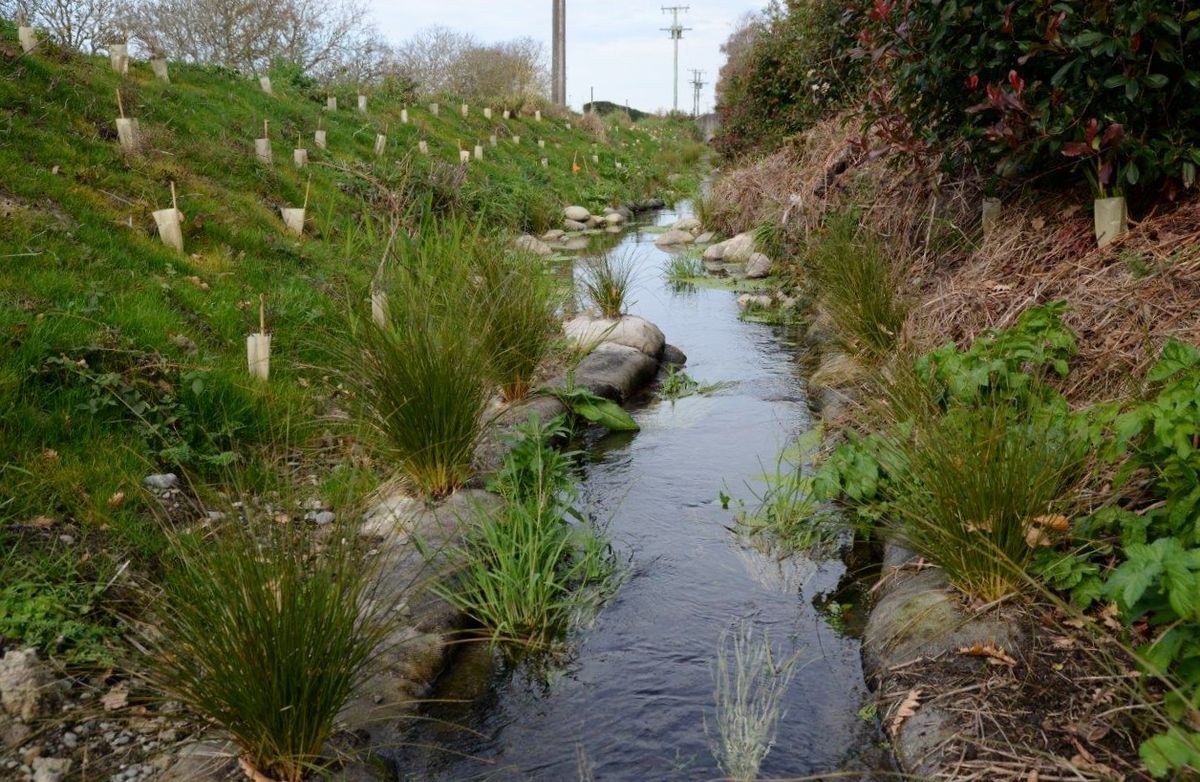
Powell’s Road Waterway Enhancement
What is the problem?
Agricultural drains are great for draining land and enabling farming, but the way they’re managed isn’t great for freshwater biodiversity or mahinga kai. These often straight, channelised waterways make up a lot of the remaining habitat for our freshwater biodiversity in lowland Aotearoa/New Zealand. Although sometimes inconspicuous in the agricultural landscape, they can make up the majority of a catchment’s waterway network, before flowing into larger streams and rivers and eventually receiving environments such as estuaries and lagoons.
Prior to human settlement, much of the land in the Ararira/LII catchment was swamp forest dominated by kahikatea and matai. Numerous waterways, arising as springs, followed meandering courses through the swamp to Te Waihora/Lake Ellesmere, which was much larger than currently is. This land was drained to make way for settlement and farming, and a network of artificial drains was created to channel water. Although the swamp forest has long gone, the spring water still supports fish and invertebrate communities and its quality has a critical influence on the health of the lake.
The Selwyn District Council now maintains the large drainage network with rates funding collected from local landowners.
The drains are often mechanically cleared of excessive aquatic weeds and sediment to ensure adequate flows, but this results in:
- uniform habitat suited to some, but not all, aquatic species
- regular disturbance of aquatic life and habitat
- a lack of cobble and woody debris habitat
- limited opportunity for riparian shade planting
- removal of fish and invertebrates
- sediment discharge downstream
- over-steepened banks
- slumping and erosion
- unnecessarily deep drains
Who could use this information?
Anyone who has a drain on their land, is responsible for drainage networks or offers environmental advice such as regional and district councils, catchment managers, farmers, farm consultants, land advisors and community groups.
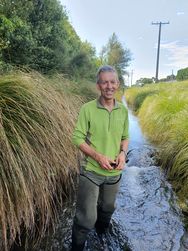
Robin Smith
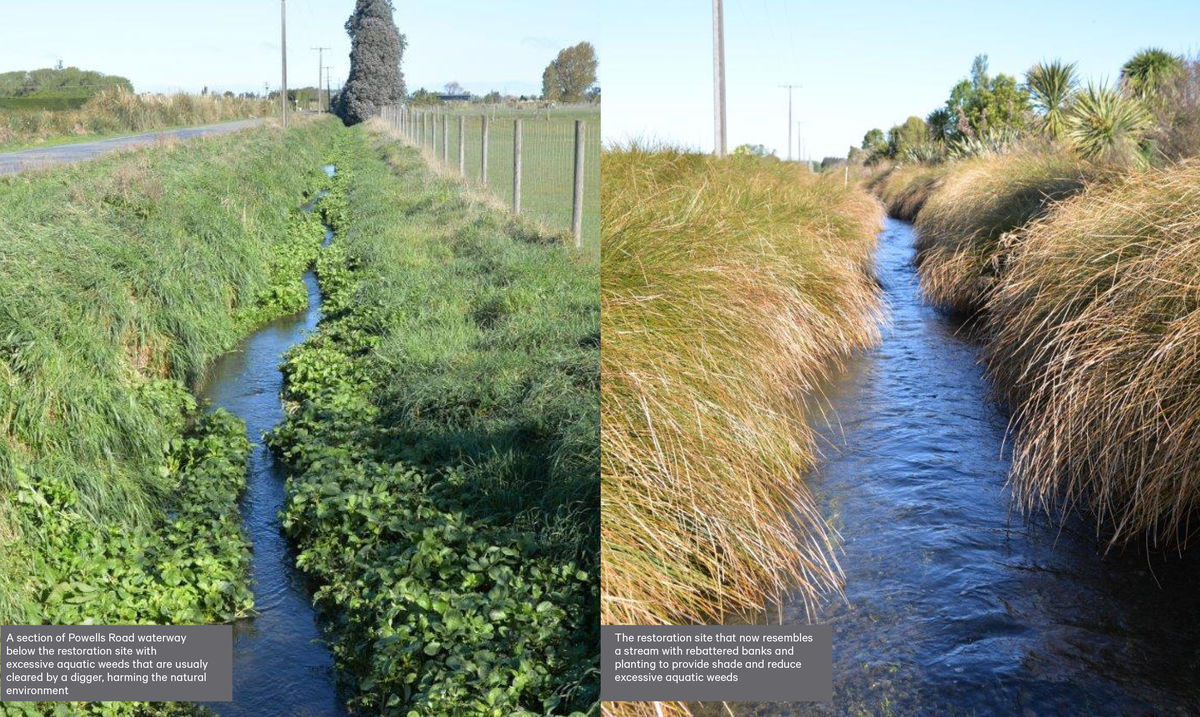
What is the project?
Living Water has been trialling different ways of managing drains to restore mahinga kai and freshwater habitat while still providing drainage function.
A 500 metre stretch of roadside spring-fed drain in Powells Road, Springston, was selected in 2017 to trial a range of tools to reduce excessive aquatic weeds (macrophytes), stabilise banks and improve instream habitat.
What was done at Powell’s Road?
Living Water teamed up with an adjoining landowner and Fonterra dairy farmer, North Canterbury Fish and Game Council, Te Taumutu Runanga, the LII Drainage Committee, Springston Primary School and local consultants and contractors to plan and implement the project.
The project involved several phases and key actions including:
- A baseline survey in 2017 of water quality, flow, habitat, fish and invertebrates
- Resource consent from Canterbury Regional Council for bank re-shaping and instream works
- Agreement from the LII Drainage Committee and approval from Selwyn District Council
- Removal of accumulated spoil on the banks and bank re-shaping
- Planting of native sedges and trees and shrubs
- Installation of instream features such as cobbles (rocks of various sizes)
- Narrowing of some small sections of baseflow channel to increase water velocity
- Seeding of banks with dwarf perennial ryegrass between plantings to reduce erosion
- Hand removal of aquatic weeds during the plant establishment phase
- The involvement of Springston Primary School students in 2018 to enable them to research, design and implement works in a 50m section and share their ideas with others
- A repeat survey in 2019 of the initial baseline survey
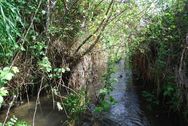
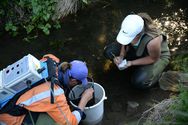
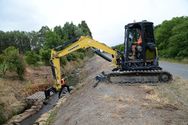
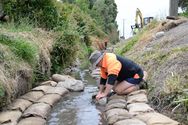
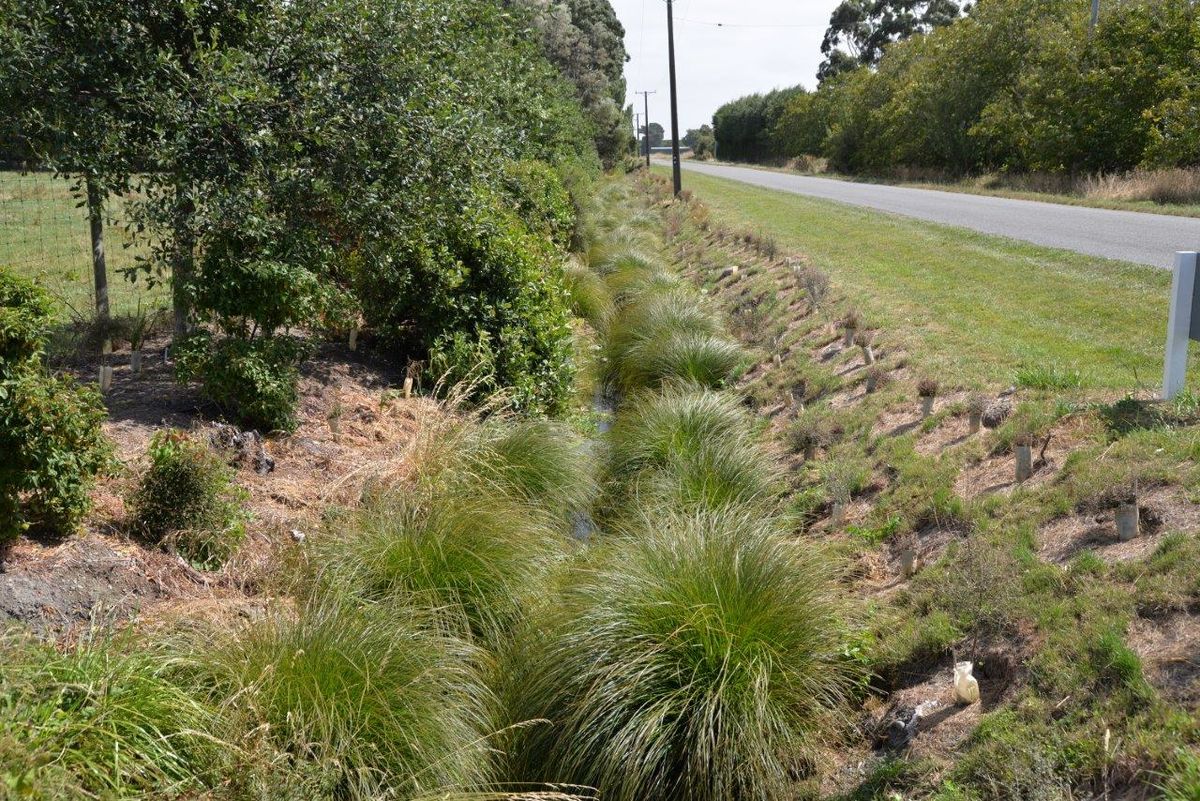
What did Living Water learn from this project?
A range of lessons were learned from this project over successive years and with different seasonal influences. The main lessons are:
- Where possible banks should be re-shaped to less-steep angles to reduce erosion from collapsing banks. Drain capacity will also be increased. It’s likely that significant amounts of sediment enter drains from over-steepened banks
- Planting sedges and trees/shrubs will provide shade and in the medium to long term significantly reduce the amount and vigour of emergent aquatic weeds such as monkey musk (Erythranthe guttata) and watercress (Nasturtium officinale). Planting needs very careful consideration. Access to drains with machinery may be required so planting should not inhibit this. Use sedges or low growing shrubs where access is required. Large trees shouldn’t be planted under overhead power wires. Plant spacing is crucial to achieve canopy closure on banks, to provide effective shading and to ensure water flows are not constricted
- Planting sedges such as purei/pukio (Carex secta) can be a very effective way to establish shade quickly especially if larger grade plants are used. Pukio should be planted at 1.5m spacings along a bank with at least a 2m wide space between plants on opposite banks in narrow drains to allow for water flow
- Weed control during plant establishment is essential and ongoing weed control is inevitable if the investment of planting is to be maintained in the long term.
- Cobbles (small to medium sized rocks) can be used very effectively and cheaply to increase instream habitat variability. They don’t impede flood flows but should only be installed in drains where measures to reduce aquatic weeds and sediment have been taken and mechanical clearance is rare or not needed. The addition of cobbles may result in sediment accumulation upstream of the cobbles so sediment control such as sediment traps, may be a worthwhile addition
- Following bank re-shaping, the application of grass seed, such as dwarf perennial ryegrass, will stabilise slopes and reduce soil loss. Spot spray around plants to maintain the grass cover or use selective herbicides
- While riparian plants are establishing, shade to reduce aquatic weeds will be limited so aquatic weed control will be necessary. Hand removal is possible (wear waders and gloves) over short sections (e.g. 1-2 kms) but regular removal is crucial. Once aquatic weeds such as monkey musk get established in late spring-early summer then hand removal is very difficult and time consuming
- Resource consent may be required and landowner approval must be sought. These crucial requirements must be attended to as early as possible to avoid delays with the timing of site works.
- Shading from plants, the addition of habitat features, the reduction in mechanical clearance and disturbance will all help to improve freshwater habitat but don’t expect to see immediate improvements to fish and invertebrate diversity and abundance. Creating the opportunity for improvements to biodiversity and water quality through the application of all the restoration tools is the first crucial step with drain rehabilitation
- The application of other tools such as two-stage channels, baseflow channel narrowing, in-line wetlands and sediment traps and others will also help improve freshwater ecosystem health
- The lessons learned from this project and others are being used in the Ararira/LII Drains to Streams project, a partnership with Selwyn District Council (SDC), Environment Canterbury, Te Taumutu Rūnanga and members of the LII Drainage Committee to combine small-scale trials with other mitigations, such as large scale sediment traps, two stage channels, strategic land use change, detention ponds, wetland enhancement and other ideas from around the world to create a plan that supports ecological, cultural and drainage values across the whole catchment
Media and related projects
Stuff story written in 2018 about the project
Waituna Creek Restoration Project - a large-scale restoration using some of the lessons learned from this project
Ararira-LII Catchment Redesign project integrates lessons from Living Water's projects into a catchment plan to be presented to the Selwyn District Council, outlining how the catchment could be managed to meet biodiversity outcomes, restore mahinga kai, improve water quality and continue to provide drainage